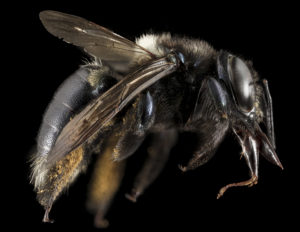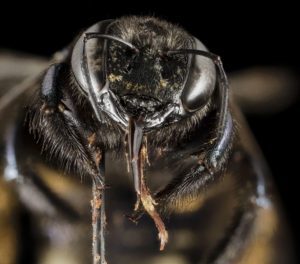Texas A&M AgriLife Extension – Carpenter Bees
Identification

Xylocopa micans (Photo credit: USGS Bee Inventory and Monitoring Lab)
Carpenter bees are large pollinators (approximately ¾ to 1 inch in length) that are often mistaken for bumblebees and vice versa. One distinguishing characteristic is that carpenter bees have a shiny black abdomen that has few hairs. On the other hand, their thorax is very hairy and can have yellow, orange, or white coloration depending on the species. You may even come across some species of carpenter bees that are smaller and have a shiny, metallic blue-black or green and purple coloration. However, you will most likely notice the larger carpenter bees.
Carpenter bees are generalists, meaning that they feed on, and therefore pollinate, a variety of plants and crops. Like bumblebees, they use sonication to vibrate and loosen the pollen from a flower’s anthers. This behavior is often referred to as “buzz pollination”. Due to their large size, carpenter bees often cannot reach a flower’s nectar source. Instead they cut an opening at the base of the flower to access the nectar, effectively becoming “nectar robbers”. As a downside other bees will access the nectar through these openings and the flower will not get pollinated.
Carpenter bees are solitary insects, meaning that there is only one active bee per nest that is responsible for the variety of tasks needed to maintain the nest. These bees prefer to nest in weathered wood, such as siding of a building, fence posts, decks, and eaves. When excavating a new nest, the foundress female carpenter bee will drill an entrance hole that is nearly perfectly round and is approximately ½ inch in diameter. She will then drill a 1-inch hole into the wood before making a right angle and excavating a gallery that is on average between 4 to 6 inches long. If you are concerned about carpenter bees taking up residence around your home, you can protect wood surfaces by keeping it coated with polyurethane or an oil-based paint.

Xylocopa micans (Photo credit: USGS Bee Inventory and Monitoring Lab)
Biology
Carpenter bees emerge in the early spring after overwintering in their nest galleries. After emergence, the females will mate and begin to build a new nest. They may utilize an old nest or excavate a new one. Once excavation is complete, the female will collect pollen and nectar to combine to make a “bee bread” for her future progeny. She places the first ball of bee bread at the end of the tunnel and lays an egg on it. Then she constructs a barrier made of chewed wood fiber to seal off the cell. She repeats this process until there are 6 to 9 cells in the gallery.
Typically, there are at least 2 generations of carpenter bees produced each year. In warmer climates carpenter bee activity and breeding can progress throughout the year.

